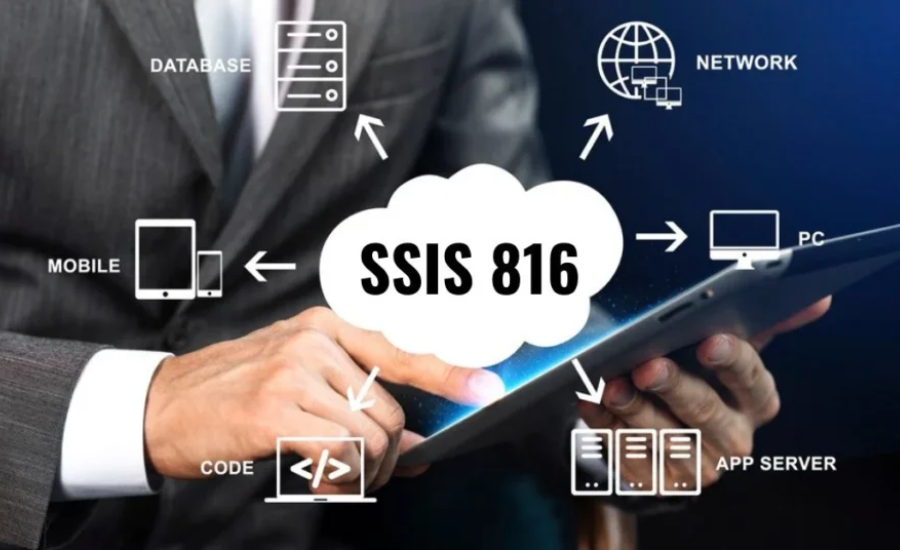Introduction
Welcome to the world of SSIS 816, where data integration becomes effortless and efficient. If you’ve ever struggled with managing and transforming large volumes of data, you’re about to discover a game-changing solution. SSIS 816 offers a comprehensive approach to data integration, ensuring that even the most complex tasks are handled with ease. In this post, we’ll explore the fascinating history of SSIS 816, its standout features, practical usage, and common applications. Additionally, we’ll delve into the challenges it addresses and its future potential in the ever-evolving landscape of data management. Whether you’re a seasoned data professional or just embarking on your data integration journey, this article aims to provide you with valuable insights into the capabilities and advantages of SSIS 816, showcasing how it can revolutionise your approach to handling data.
With a deep dive into SSIS 816, you’ll gain an understanding of how it simplifies the process of integrating disparate data sources and transforming data into valuable insights. This powerful tool has evolved over the years to meet the growing demands of data management, offering features that streamline data workflows and enhance efficiency. We’ll look at how to effectively use SSIS 816 in real-world scenarios, from data warehousing to ETL processes, highlighting its role in various industries. Furthermore, we’ll discuss the challenges commonly encountered in data integration and how SSIS 816 mitigates these issues, paving the way for smoother operations. As we gaze into the future, we’ll consider the ongoing advancements and how SSIS 816 is poised to remain a crucial player in the realm of data integration. Prepare to unlock the potential of seamless data integration with SSIS 816 and elevate your data management practices to new heights.
What exactly is SSIS 816?

SSIS 816, short for SQL Server Integration Services 816, stands as a robust data integration solution crafted by Microsoft. Seamlessly integrated into the broader SQL Server suite, its primary mission revolves around streamlining the extraction, transformation, and loading (ETL) of data from various sources into a central database hub.
This tool’s versatility shines through its ability to effortlessly connect with a multitude of data sources, spanning from Excel spreadsheets and flat files to databases and web services. Such flexibility paves the way for comprehensive data gathering, fostering a consolidated pool ripe for thorough analysis and reporting endeavours.
What truly sets SSIS 816 apart is its user-friendly visual interface, empowering developers to architect intricate ETL processes sans the need for extensive coding endeavours. Thanks to its intuitive drag-and-drop functionality coupled with an extensive repository of pre-built tasks and transformations, crafting efficient workflows becomes a breeze, automating tedious and repetitive tasks effortlessly.
Moreover, SSIS 816 boasts robust error handling mechanisms, ensuring any hiccups encountered along the data integration journey are promptly addressed. Its repertoire also extends to encompass advanced features like parallel processing and incremental loading, catering to the demands of handling mammoth data volumes with utmost efficiency.
In essence, SSIS 816 emerges as a formidable ally for organisations seeking heightened command over their data integration endeavours. Whether it entails routine database updates or orchestrating the migration of legacy systems to contemporary platforms, this tool stands as a comprehensive solution poised to address diverse data integration needs with finesse and efficiency.
The Evolution of SSIS 816: A Journey Through Data Integration Excellence
The journey of SSIS 816, from its inception to its latest version, is a captivating narrative that underscores the evolution of data integration and ETL processes. SSIS, or SQL Server Integration Services, made its debut back in 2005 as part of Microsoft’s SQL Server suite, marking a pivotal moment in data management for organisations worldwide.
Since its introduction, SSIS has undergone a series of updates and enhancements to adapt to the evolving landscape of data management. Each new version, including the latest SSIS 816, has been meticulously crafted by Microsoft to enhance performance, scalability, and user-friendliness, catering to the ever-changing needs of data-driven organisations.
The development of SSIS 816 has been heavily influenced by technological advancements, particularly in cloud computing and big data analytics. This latest iteration boasts improved support for a wide array of data sources, both on-premises and in the cloud, alongside advanced features tailored for data cleansing, transformation, and seamless loading into target systems.
A significant milestone in SSIS’s history was its integration with Visual Studio IDE, a move that revolutionised ETL development. By providing developers with a user-friendly graphical interface, SSIS empowered both programmers and non-programmers alike to design intricate data integration workflows, marking a paradigm shift in the accessibility and efficiency of ETL solutions.
Microsoft’s unwavering commitment to innovation is evident in its continuous investment in research and development for SSIS. Regular updates and patches are rolled out to address bugs and introduce new features, all based on invaluable customer feedback. As SSIS continues to evolve, it transforms from a basic ETL tool into a robust platform capable of meeting the diverse data integration needs of modern organisations, with each iteration like SSIS 816 unlocking new possibilities for extracting insights from vast datasets.
Exploring the Key Features
SSIS 816 emerges as a formidable data integration solution, boasting a plethora of essential features designed to streamline the intricate processes of data management. Among its standout capabilities is its remarkable versatility in connecting with diverse data sources, ranging from databases to XML files. This flexibility enables seamless extraction and transformation of data from multiple origins into a centralised repository, laying the groundwork for comprehensive analysis and insights.
The tool’s intuitive visual interface stands as another noteworthy attribute, democratising the realm of ETL workflows. With drag-and-drop functionality and an extensive library of pre-built tasks, even users with limited technical expertise can swiftly construct complex data pipelines, eliminating the arduous need for custom coding. This not only saves valuable time but also enhances efficiency across departments, fostering a culture of productivity.
Unlocking the Benefits
SSIS 816 doesn’t just stop at offering a user-friendly interface; it also provides robust error handling mechanisms, ensuring data integrity throughout the integration process. Built-in logging mechanisms track package execution, swiftly identifying and addressing any encountered errors or failures, thus simplifying troubleshooting. Moreover, the tool’s exceptional scalability, bolstered by support for parallel processing, ensures efficient handling of large data volumes, further enhancing performance and productivity. Seamless integration with Microsoft’s suite of tools facilitates smooth collaboration between teams, underscoring SSIS 816’s commitment to fostering a cohesive data ecosystem. Ultimately, these key features culminate in substantial benefits for businesses, ranging from increased efficiency and improved data quality to significant cost savings. SSIS 816 emerges as an invaluable asset for organisations seeking to optimise their data integration endeavours, empowering them to unlock the full potential of their data resources.
Getting Started with SSIS 816

To embark on your journey with SSIS 816, the first step entails installing the tool on your system. Begin by downloading the latest version of SQL Server Integration Services (SSIS) 816 package, ensuring you have the necessary prerequisites in place. Once installed, launch Visual Studio and open the Integration Services Project template to initiate your project setup. Assign a meaningful name to your project and select the target server version that aligns with your requirements.
Building Your Data Integration Project
With your project created, it’s time to start adding data sources. Utilise the available connectors to import data from diverse sources such as flat files, databases, or APIs into your SSIS project. Next, focus on designing the control flow of your project by defining the workflow. Arrange tasks within sequence containers, for loops, or conditional statements, configuring each task with specific properties to meet your project’s requirements.
Executing and Managing Your Packages
Once your project is set up and the workflow is defined, you’re ready to execute your packages. Execute packages manually through Visual Studio for immediate processing or schedule them to run at specific intervals using SQL Server Agent Jobs for automated execution. Implement error handling mechanisms and enable logging to capture any issues encountered during package execution, ensuring smooth operation and facilitating troubleshooting as needed. With these steps, you can effectively utilise SSIS 816 to streamline your data integration processes and unlock the tool’s full potential.
Advancements and Innovations in SSIS 816
SSIS 816 introduces key elements and upgrades aimed at enhancing data integration capabilities. It offers advanced features that streamline the integration of data from diverse sources, including databases, cloud services, and flat files, fostering a holistic approach to data management.
Performance optimization is a central focus in SSIS 816, with enhancements geared towards reducing latency and improving throughput. Whether handling small-scale data transformations or processing large volumes of data, SSIS 816 ensures optimal performance and scalability, catering to varied data processing needs.
Data security is paramount in today’s digital landscape, and SSIS 816 addresses this concern with robust security measures. From encryption options to access control mechanisms, it provides the necessary tools to safeguard sensitive data throughout the integration process.
The intuitive user interface of SSIS 816 simplifies the design and deployment of data integration workflows. With drag-and-drop functionality and visual design tools, users can create complex data transformation pipelines effortlessly, reducing development time and effort.
Looking towards future trends, SSIS 816 incorporates AI-driven integration capabilities, enabling users to leverage AI algorithms for data preprocessing and analysis. This integration opens up new avenues for automating data transformation tasks and uncovering valuable insights from vast datasets.
Exploring Common Applications of SSIS 816
SSIS 816 stands as a versatile solution with robust capabilities, finding widespread applications across various industries and sectors. Let’s delve into some prevalent use cases where SSIS 816 emerges as a valuable asset.
Streamlining Data Integration Processes
At the core of its functionality, SSIS 816 excels in data integration tasks. Organisations leverage its capabilities to seamlessly extract data from diverse sources, tailor it to their requirements through transformation, and seamlessly load it into target systems. Whether consolidating data from disparate databases or amalgamating structured and unstructured data, SSIS 816 handles these tasks efficiently.
Powering ETL Processes
Modern enterprises rely heavily on Extracting, Transforming, and Loading (ETL) processes to maintain accurate and up-to-date data repositories. SSIS 816 facilitates this crucial function with its intuitive interface and robust transformation capabilities. Developers can effortlessly design intricate ETL workflows, automating the extraction, cleansing, validation, transformation, and loading of data.
Driving Business Intelligence Initiatives
SSIS 816 plays a pivotal role in constructing business intelligence solutions by seamlessly integrating disparate datasets from various sources. Leveraging its comprehensive set of components, organisations can harness SSIS 816 to create insightful reports and dashboards, aiding informed decision-making processes.
Supporting Data Warehousing Solutions
Efficient data warehousing demands powerful tools like SSIS 816, capable of handling large volumes of data effectively. With features such as parallel processing and optimised memory utilisation, SSIS 816 ensures high-performance loading into the warehouse while upholding data integrity.
Simplifying Migration Projects
During migration endeavours, whether transitioning from legacy systems to modern platforms or upgrading existing infrastructure, SSIS 816 streamlines the process by facilitating the seamless transfer of large datasets with minimal downtime.
Enabling Real-time Data Integration
In today’s dynamic business landscape, real-time insights are paramount for maintaining competitiveness. SSIS 816 facilitates the integration of real-time data streams, empowering organisations to make informed decisions promptly.
Navigating Challenges and Limitations in SSIS 816

While SSIS 816 boasts a plethora of robust features, users often encounter challenges and limitations when leveraging this powerful tool. One common hurdle is the steep learning curve associated with mastering SSIS 816’s intricate functionality. Given its reliance on SQL Server Integration Services and ETL processes, beginners may find it daunting to navigate through its extensive capabilities effectively.
Another limitation of SSIS 816 is its lack of real-time data integration capabilities. While it excels at batch processing tasks, handling high-volume streaming data requiring immediate processing and analysis may prove challenging for the tool.
Scalability can also pose challenges for large-scale data integration projects utilising SSIS 816. While it efficiently handles moderate-sized datasets, performance issues may arise when dealing with massive data volumes or complex transformations.
Maintenance and troubleshooting in SSIS 816 can be laborious due to the complexity of package configurations and dependencies. Debugging errors or identifying workflow bottlenecks often requires substantial effort from developers, contributing to time-consuming tasks.
Moreover, SSIS 816’s limitations extend to cross-platform compatibility. Primarily designed for Microsoft environments and reliant on Windows-based servers, integrating heterogeneous systems or non-Microsoft technologies may present difficulties for users.
Charting the Future Trajectory of SSIS 816
The horizon for SSIS 816 appears promising as it strides forward, adapting to the dynamic landscape of data integration and ETL processes. Propelled by technological advancements, several trends are poised to shape its future trajectory.
One significant trend is the escalating demand for real-time data integration. Businesses increasingly rely on instantaneous insights to fuel informed decision-making, a need SSIS 816 adeptly addresses with its capability to swiftly and efficiently handle vast volumes of data.
Moreover, the ascent of cloud-based solutions emerges as another pivotal trend. With organisations migrating operations to the cloud, SSIS 816 stands ready with seamless integration options for popular platforms like Azure Data Factory. This facilitates effortless data transfer and transformation between on-premises systems and cloud environments.
Furthermore, the spotlight shines brightly on automation and AI-driven capabilities within data integration. SSIS 816 is already embracing this trend by incorporating features such as machine learning models for advanced transformations and automated error handling. These innovations empower users to streamline workflows and enhance operational efficiency.
Additionally, amidst escalating cybersecurity concerns worldwide, SSIS 816 is expected to bolster its security measures. This includes fortifying encryption protocols, ensuring compliance with industry regulations, and furnishing comprehensive auditing capabilities. Such endeavours will further cement SSIS 816’s position as a stalwart guardian of data integrity and security in the evolving digital landscape.
FAQs
Q1. What is SSIS 816?
A1. SSIS 816, also known as SQL Server Integration Services 816, is a robust data integration tool developed by Microsoft. It is designed to streamline the extraction, transformation, and loading (ETL) of data from various sources into a centralised database.
Q2. What are some key features of SSIS 816?
A2. SSIS 816 offers a user-friendly visual interface, versatile connectivity with various data sources, robust error handling mechanisms, scalability, and advanced features like parallel processing and incremental loading.
Q3. How has SSIS 816 evolved over time?
A3. SSIS 816 has undergone continuous updates and enhancements since its introduction in 2005. Its evolution has been driven by advancements in technology, particularly in cloud computing and big data analytics, leading to improved performance, scalability, and ease-of-use.
Q4. What are some common applications of SSIS 816?
A4. SSIS 816 finds applications across various industries and sectors, including data integration, ETL processes, business intelligence, data warehousing, migration projects, and real-time data integration.
Q5. What are some challenges and limitations of SSIS 816?
A5. Users may face challenges such as a steep learning curve, limitations in real-time data integration, scalability issues for large-scale projects, and maintenance/troubleshooting complexities. Additionally, cross-platform compatibility may pose challenges for integrating non-Microsoft technologies.
Conclusion
In conclusion, SSIS 816 stands as a powerful and versatile solution for data integration, offering a wide array of features and capabilities to streamline complex workflows. From its inception to its latest iteration, SSIS 816 has evolved to meet the ever-changing demands of data management, catering to various industries and sectors. While it presents challenges and limitations, such as a learning curve and scalability issues, its future remains promising with advancements in real-time integration, cloud solutions, automation, and cybersecurity measures. As organisations continue to harness the potential of SSIS 816, they can unlock new possibilities in data management and decision-making, driving efficiency and innovation in the digital era.



